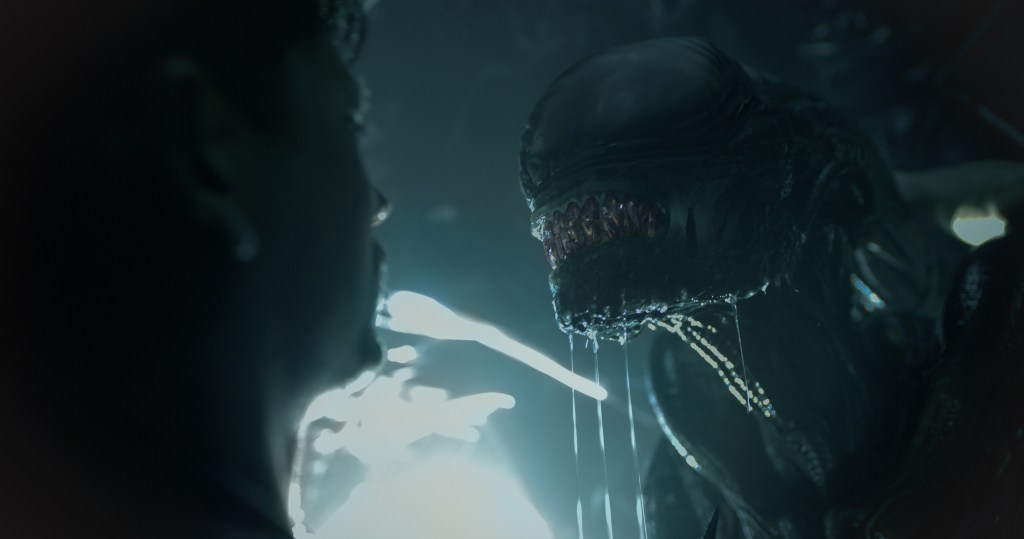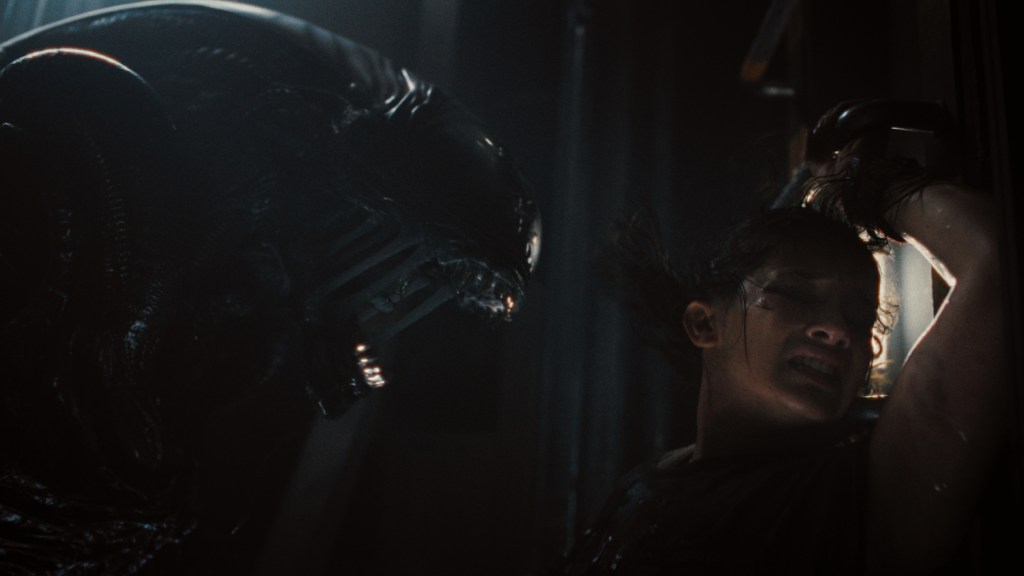It takes a good forty minutes of Alien: Romulus before any (living) aliens actually show up, and ironically, that stretch may be the best part of the movie. It certainly adds more to the general mythology than most, giving us a look at the life of a factory worker on an outpost planet run by Weyland-Yutani, the evil monopoly corporation that’s mostly to blame for the sorry state of the future in the Alien movie universe. It’s essentially a space maquiladora, where the youngest workers hope for the intergalactic equivalent of making a run for the border, to distant worlds beyond the grasp of earthly capitalism.
Rain (Cailee Spaeny) is just about to reach the end of her current contract and make that move, until her quota is arbitrarily upped again, forcing her to consider more desperate measures. Some friends of hers have discovered an abandoned corporate spaceship on the sensors, and somehow have access to a rocketship that can get them all to it, since apparently the company itself isn’t paying much attention, either to space debris or possible escapees.
No Walls in Space
Maybe they don’t consider any factor in that equation a threat, but Rain happens to have an android brother named Andy (you think that’s short for “android,” but no, it’s because his serial number begins with “ND”), and androids can hack into Weyland-Yutani property. Rain’s dad was apparently a genius who found Andy (David Jonsson) in the junk and reprogrammed him with the personality of a mentally challenged child. (Later he gets an upgrade, and becomes more like a high-functioning autistic genius.)

Director Fede Alvarez knows his Alien franchise perhaps too well — he’s clearly the kind of superfan who will insist the creatures are officially called xenomorphs, and ensures all the characters say that rather than “alien.” The first third of the movie takes its cues from the original Alien, with working-class folks finding their trip into space taking a turn they didn’t expect. The middle-section, on a derelict space station, recalls the Isolation video game, as humans play hide and seek with creatures. The finale is Alvarez’s attempt to do Alien Resurrection, but good.
And it’s not like he’s only referencing those three movies — there are constant callbacks in visuals, scenes, and dialogue, whether or not it makes any narrative sense in the moment. The most elaborate of these is too good to spoil, but it’s likely to be divisive, though it’s pulled off more successfully than similar things in analogous movies. Pardon the vagueness but you’ll understand when/if you see it.
Lion in His Pocket
The challenge with any Alien movie is to get us scared of things that we know all too well by now. In 1979, with a groundbreaking, horrific bio-mechanoid, phallic H.R. Giger design and a disgusting life cycle based on gall wasps, the signature monster was terrifying. Now, all these movies and endless broad-daylight merchandise later, it’s like looking at a lion: I know on a rational level that it can kill a person, but just seeing one isn’t in and of itself scary, and seeing its predictable hunting patterns can’t sustain two hours.

Alvarez remembers that the real enemy in these movies is corporatism and human mistrust, which is a decent starting point. He also offers impressive visuals, with an eternally dark and rainy planet leading us into a depressingly grim ringworld orbit and a haunted-house-style space station, divided into “Romulus” and “Remus” sections for no important reason I could discern. It’s no spoiler to say there are xenomorphs aboard, because of course there are, but refreshingly, there’s more plot than just them, even if it is derivative. (There are some leads one presumes the upcoming TV series will pick up.)
There are also nods to 2001, because rare is the filmmaker who can help themselves; in this case, Alvarez has composer Benjamin Wallfisch (Blade Runner 2049, natch) score every appearance of the classic creature with an eerie choral dirge very similar to the one that accompanies the Monolith in Kubrick’s classic.
Timing
Alien: Romulus is in some ways a legacy sequel, in that, timeline-wise, it follows the first Alien, and can ignore the rest that haven’t happened yet. (It does briefly acknowledge Prometheus, which has.) But while it reboots with a younger-than-usual cast, the choice here doesn’t feel made for youth appeal per se; rather, it offers young adults who feel way in over their heads, yet desperate enough to leave a life of indentured servitude that sure, they’ll risk a few monsters. Jonsson is the highlight as Andy, because he’s given the biggest range to play. Spaeny is clearly the designated Ripley and knows it, while Isabella Merced’s Kay feels doomed the moment she develops morning sickness as her primary character trait. British buds Tyler (Archie Renaux) and Bjorn (Spike Fearn) play good Cockney/bad Cockney, frequently incomprehensibly.

Given what feels like a massive budget, Alvarez conjures some of the series’ most impressive visuals, like a zero-gravity escape through swirls of acid-blood that feels like a video game’s extra-challenge bonus level, and that ever-present ringworld outside that keeps getting closer. His best spin on a classic reference is the trip into space: it’s a reversal of Aliens’ dropship descent, but in a theater and on a large screen, has just as much sound and vibration for a real you-are-there feel. Unfortunately, by the time he has a character say, “Get away from her, you bitch!” and it’s a character who decidedly would not say those exact words, based on everything we’ve seen from them, we’ve gotten more than enough already.
Xenomorphs’ll Make Ya…
Actual jumpscares are in better supply here than usual, along with an added layer of body horror and grossness that isn’t for everyone. Pregnant people may be advised to tread gingerly, and Alvarez likes to remind us, by showing the crablike baby critters repeatedly trying to assault throats with their phallic probes, that “facehugger” is a real euphemism, when what they’re actually trying to do is something else that begins with “f.”

When Alien Romulus actually does new things — new scares, new variations on creatures, characters we haven’t seen before — it really cooks. Whether it’s due to the fanboy in Alvarez or a studio that insists upon “I understood that reference!” moments ad nauseam, though, it all gets a bit bogged down in ‘member-berries. Say what you will about David Fincher’s Alien3, but it at least tried to come up with a completely different ending from the rest. Romulus isn’t the worst Alien movie: it’s better than at least two of the others, but not any kind of bold new course for the franchise. As glossy as it is — and the gore is deeply red and satisfying — it’s ultimately just a really high-tech photocopy.
Grade: 2.5/5
Alien: Romulus opens August 16 in theaters.





